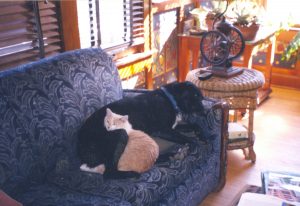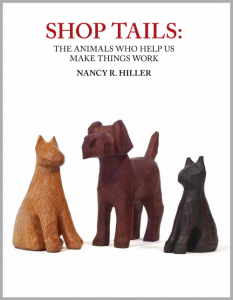[Publisher’s note: Yaël Ksander has recorded a version of this review for Inner States, a weekly show on WFIU Public Radio and a podcast “about art, culture, and how it all feels, in Southern Indiana and beyond.” The show can be heard on WFIU on Sundays at noon and on the Inner States podcast. Limestone Post and Inner States have partnered to bring you more of Yaël’s reviews, so stay tuned!]
A mourning dove with a broken wing. A mouse kept in a schoolgirl’s pocket. A parrot, a guinea pig, and an endless parade of cats and dogs. If we are to believe her most recent book, Nancy Hiller’s never met an animal she doesn’t like, and isn’t willing to be seriously inconvenienced by. There were times while reading Hiller’s Shop Tails: The Animals Who Help Us Make Things Work (Lost Art Press, 2021) when I was transported to the adventure stories I loved as a child — in which a crafty runaway named Kit fashions a lean-to and befriends a mountain lion. (The teleplay version of which would have starred Jody Foster and aired on The Wonderful World of Disney on Sunday nights.) At the bookstore, Hiller’s tales might easily get sorted with the recollections of British veterinarian James Herriot — whom Hiller in fact cites in the bibliography. But All Creatures Great and Small — now on PBS’s Masterpiece! — was comfort reading for me as a kid, a refuge from a less comfortable reality. Neither fish nor fowl, Hiller’s new memoir dares to inhabit both places.

Nancy Hiller eating wood shavings in her workshop. An accomplished woodworker, Hiller is also the author of the books ‘Shop Tails: The Animals Who Help Us Make Things Work,’ ‘Making Things Work: Tales from a Cabinetmaker’s Life,’ and ‘The Hoosier Cabinet in Kitchen History,’ among others, as well as articles in several trade publications. | Courtesy photo
“I did not set out to write a memoir,” Nancy insisted when I interviewed her in 2017 about her book Making Things Work: Tales from a Cabinetmaker’s Life (Lost Art Press, 2017). The book cover is festooned with hand tools and takes as its ostensible subject matter her encounters in the trade. “Frankly,” said Hiller, who has lived in Bloomington for the past three decades, “whenever I see people refer to this book as a memoir I feel a little embarrassed because I am not the sort of person who thinks she is worthy of writing a memoir.”
It is one of life’s great ironies that imposter syndrome grips some of the most interesting and accomplished people. If the life of a woman who has not only made a living but also distinguished herself over the past four decades in the overwhelmingly masculine orbit of fine woodworking is not worthy of memoir, whose is? Add to that a Florida childhood wherein hippies built shanties in the backyard and shared psychedelic drugs with the 11-year-old Nancy; a stint at a Dickensian boarding school in England and eventual matriculation at Cambridge; her early 20s spent cycling to and from (uphill both ways in the rain, no doubt) a furniture-making apprenticeship amid a cast of 19th-century lunch-pail types; a return to the academy in her 30s for a master’s in Religious Studies; an all-in approach to romantic relationships and the places they’ll take you; and an uncompromising dedication to her craft come poverty, crippling health insurance costs, sleeping where you have to, and peeing in a bucket.
These and many other stories of the Rebel Girl who is Nancy Hiller can be found in that first memoir-that-is-of-course-a-story-about-cabinetmaking and her latest, which is of course “about” animals. But just like your shrink might tell you that the thing you think you’re upset about is not the thing you’re really upset about, there’s a difference between subject matter and content. Even before this pair of memoirs, Hiller’s been known to dissemble behind subject matter. Certainly she’s published miles of words taking a straightforward approach to her craft in Fine Woodworking, Old-House Journal, and many other trade publications. But she’s a sly one.
In The Hoosier Cabinet in Kitchen History (Indiana University Press, 2009), Hiller pushed a big old piece of furniture in front of her so she could actually talk about the evolution of women’s place in the home and the world. Hiller was at it again in 2011, with a lush coffee-table book illustrated with gorgeous interiors photographed by Bloomington-based Kendall Reeves. A Home of Her Own (IU Press, 2011) could have passed for a home-improvement guide if you didn’t also read the stories of the women who had saved and transformed these old houses and in the process saved and transformed themselves. “These are women who are not just creating spaces in the HGTV kind of way,” Hiller told me at that time, “but also coming to know parts of themselves and realize many of their capabilities through working with their most intimate surroundings, in their home.” I called that fierce book “a wolf in sheep’s clothing.”

Winnie (blue collar) and Joey are part of the menagerie of Hiller’s animal companions who appear in her latest book. | Courtesy photo
With Shop Tails, it’s more fun with animal disguises — to a point. The animals in the book’s title, the wooden dog and cat figurines on the cover, and the plentiful color portraits of Nancy’s animal companions throughout the volume might convince the unsuspecting reader that this is a book about critters. But you won’t get too far into it without realizing that you’ve signed up for more than Kit and the mountain lion. The merry tales of wee mice, naughty parrots, and kitchen restorations are bookended, interrupted, and interspersed with suffering, loss, and existential reckoning. And in contrast to Hiller’s previously expressed ambivalence about contributing to the genre, the copyright page of Shop Tails acknowledges that “this work is largely a memoir.” A small step for a woman, it’s a large step for womankind when a woman decides to take up space. (Especially when, as many of the photos show, the menagerie barely leaves you room on the beautifully reupholstered couch.)
Shop Tails was written at a reckoning point. We learn in the first section of the book that Hiller is facing a life-threatening illness. Recovery, she decides, will be a function not only of medical treatment but of healing from childhood pain and the pattern it set up — constantly needing to prove her worth to others through achievement. While it might be regarded as one more bona fide in a formidable series of them, this book isn’t just another achievement; it’s an artifact of the deep healing Hiller knew she could no longer put off. Even in coming to terms with the wound, she exposes the remnants of the way she has always contextualized and justified it:
While my experience doesn’t begin to compare to that of a child raised in a household where family members go to bed hungry, or a parent is verbally or physically abusive, let alone to the experiences of children living as refugees, the sense of betrayal and the child-logical implication that my sister and I just weren’t that important to our parents, that being there for us was somehow optional, went deep.
Overwhelmed by the shame of acknowledging one’s childhood experience of suffering despite relative privilege, how many of us have diminished it in the same way, finding endless workarounds — from substance use to “type A” striving — to manage its legacy? Some of us do it till we drop; for others, as Hiller describes, the unsustainability of these coping mechanisms is revealed in a flash:
Throughout all of this, I now saw, I had moved forward in reaction to others. I was dangerously dependent on outside forces, people who expressed their opposition, no less than their approval. It suddenly felt deeply exhausting. I let my awareness of that exhaustion sink in. Whatever might happen with the course of my cancer, I was not going back to my old ways of living.
The path toward a new way of living began in the hours before her chemo port was implanted. Putting aside decades of caveats and diminishments, Nancy sat down and wrote a letter to her parents, a couple of talented and unusual individuals she had “long appreciated … as people” but “at a fundamental level … didn’t trust … as parents.” Mailing the letters and receiving her parents’ open-hearted responses proved to be a crucial step toward “savor[ing] this jewel of a life,” instead of just gutting it out. “In an instant,” Hiller writes, after receiving her father’s response, “ — and this is no exaggeration — the life I had made appeared in a new light.”
Shop Tails is a paean to that life Hiller has made, bathed in the new light that reconciliation and reorientation have afforded. In that way, the comparison with Herriot’s All Creatures series finally seems apt, given that he named it after an Anglican children’s hymn extolling the wonders of the natural world. In the same spirit, Hiller’s book records the routines and pleasures of daily life and the flora and fauna (of all species) she has encountered along the way. Not a refuge from reality — like Kit and the mountain lion were for me as a child — but a mindful embrace of it. In this reinterpretation of the events of her life, Hiller’s specialization in re-envisioning 19th- and 20th-century furniture and interiors is not incidental. The topic emerges in the story of a kitchen remodel where there was a desire to respect the “authorial intent” of the original room while at the same time a need to adapt it “to suit the family who now lived there.” Hiller’s book prompts us to think of our own life as an old house — whether we grew up in a manse or split-level, the place usually needs some restoration, rehabilitation, and creative reuse to be thoroughly functional, let alone fabulous.
 An unusual stylistic device reminds us that Shop Tails is Hiller’s own mindful reinterpretation of her life: the strike-through. Easy at first to dismiss as a proofreader’s oversight, the occasional repetition of the device at critical spots brings to the fore the writer’s active replacement of old definitions and characterizations for new ones. Her description of a dog as “completely apeshit out of control” is revised as “less restrained”; “drywall bucket” replaced by “chamber pot”; and she thinks better of characterizing her youthful cello-playing as “scratch[ing] out ear-splitting tunes.” Small point, perhaps, but one that reminds the reader that sometimes it can be helpful to tell yourself a different story about the stuff you’ve gone through and are facing.
An unusual stylistic device reminds us that Shop Tails is Hiller’s own mindful reinterpretation of her life: the strike-through. Easy at first to dismiss as a proofreader’s oversight, the occasional repetition of the device at critical spots brings to the fore the writer’s active replacement of old definitions and characterizations for new ones. Her description of a dog as “completely apeshit out of control” is revised as “less restrained”; “drywall bucket” replaced by “chamber pot”; and she thinks better of characterizing her youthful cello-playing as “scratch[ing] out ear-splitting tunes.” Small point, perhaps, but one that reminds the reader that sometimes it can be helpful to tell yourself a different story about the stuff you’ve gone through and are facing.
A shift in orientation might in fact be the antidote to the pain, loss, and suffering life brings. So much is beyond our control, Hiller concedes, “but we do have a say in how we respond.” After decades of gutting it out, producing objects for others’ approbation, Hiller’s reinterpretation of the artist’s life is an act of survival: “making something constructive out of challenging circumstances is every bit as creative as baking a loaf of sourdough bread, building a canoe or assembling a kumiko panel.”
It’s a large concession from someone who has dedicated her life to art and craft, but she wouldn’t be the first artist to do so. At his hilltop refuge in Brown County, the great American Impressionist T.C. Steele had this quotation inscribed in the mantel: “It has seemed to me that the greatest of all the arts is the art of living.” Confronted with her own mortality, and reflecting upon “those who have gone before” (to whom she dedicates the book), Hiller makes the same realization. Dogs have helped in that process. Because dogs, unlike most humans, have the good sense not to underrate the value of a predictable and contented life. A day in her beloved dog Winnie’s, for example, might have looked like this:
Get up, go out, eat breakfast. Make sure Mom, Dad and Jonas are safely off to work and school, then take a nap. Watch robins hop through the grass. … Greet the family when they come home in the evening. Eat dinner! Hang out under the kitchen table while they talk, then go sit in the living room. … Go out in the dark and tell the coyotes they’d better not even think about coming into the yard overnight. Have a bedtime cookie and a drink. Lie down with Lizzie near the woodstove for the night.
“A basic life of responsibilities, simple rewards, a loving family and rest well-earned,” Hiller observes, going on to concede that at the time she still wasn’t ready for that lesson in fulfillment. Over a decade later, in this especially uncertain time, Hiller’s acceptance of the lesson Winnie taught her offers solace for us all.


